
During the spring of 2008, I spent two months at Institute of Astronomy in Tokyo, thanks to a fellowship from the Japan Society for the Promotion of Science. While I was there, I worked with a group of astronomers,
Onward of stars in the Subaru Deep Field. Our goal was to identify stars which moved perceptibly relative to more distant objects; in other words, to find stars with high proper motions. Morokuma-san and Doi-san, in particular, had done a lot of work to look for proper motions; I helped to push things a little further. We succeeded, and have submitted a paper to the Publications of the Astronomical Society of Japan. Let me try to explain what we did.
Contents
The Subaru Telescope, run by the National Astronomical Observatory of Japan , is one of the largest in the world. Its primary mirror is a single piece of glass, 8.2 meters in diameter.

To keep this thin piece of glass from bending or warping, which would change its shape and throw images out of focus, there is a very complicated active support structure beneath it:
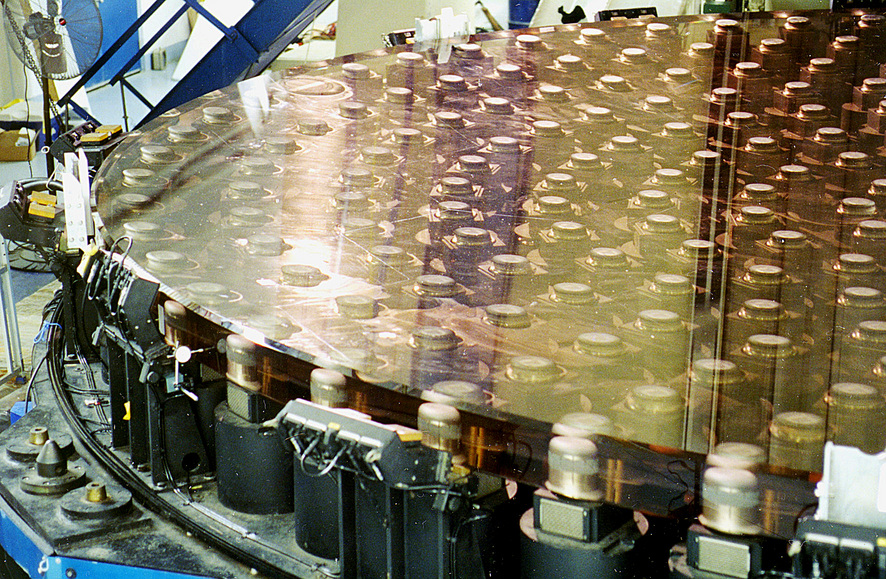
The telescope sits high atop Mauna Kea, at an altitude of 4200 meters above sea level. The entire enclosure rotates with the telescope to follow the stars.
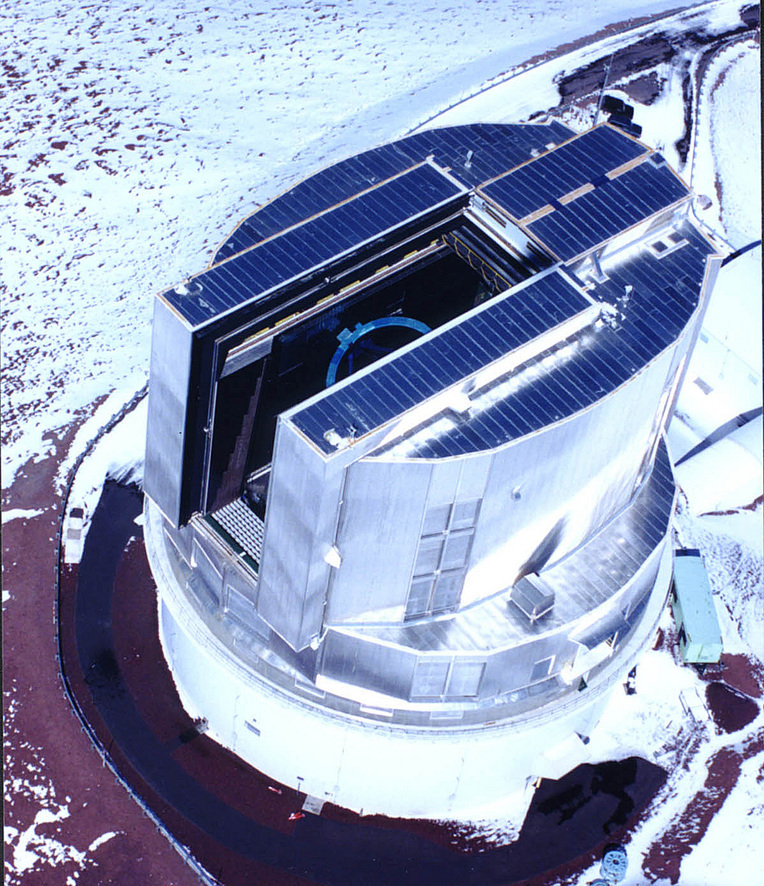
Subaru is a general-purpose telescope, with several different instruments. Many astronomers apply for time on it and point it at different objects. However, the allocation committee has given large blocks of time to several big groups so that the telescope can carry out big projects which can support many different research activities. One of these is the Subaru Deep Field. The SDF is a region about half a degree on a side, located at high galactic latitude so that it suffers little extinction from dust in the Milky Way. Its center is at
(J2000) RA = 13:24:38.9 Dec = +27:29:25.9
l = 37.6 b = +82.6
which lies just inside the boundaries
of the constellation Coma Berenices.
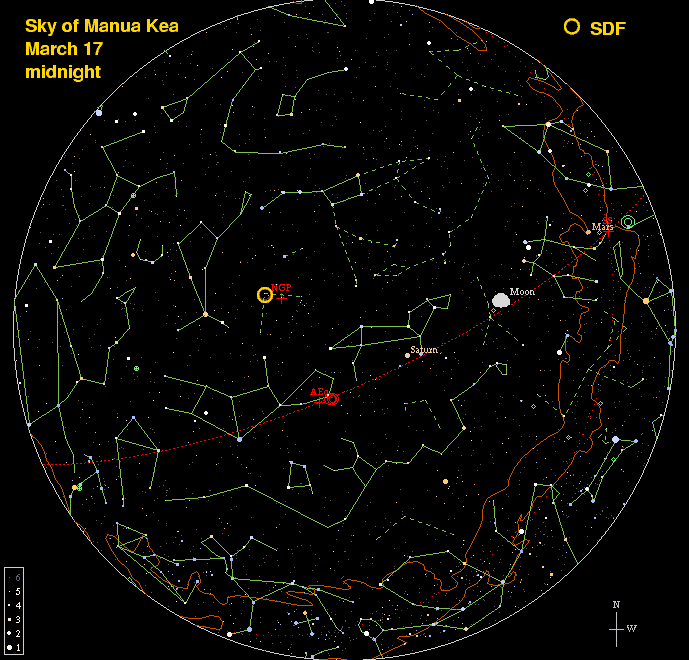
The size of the field is just about the field of view of one of the main Subaru telescopes, the Suprime-Cam. This optical camera has 10 CCD chips, each 2048x4096 pixels in size, arranged in a 2-by-5 array. At the prime focus of Subaru, it provides a field of view of 34 by 27 arcminutes. Each exposure yields a raw image 160 MB in size, so it's not trivial to do the data reduction ...
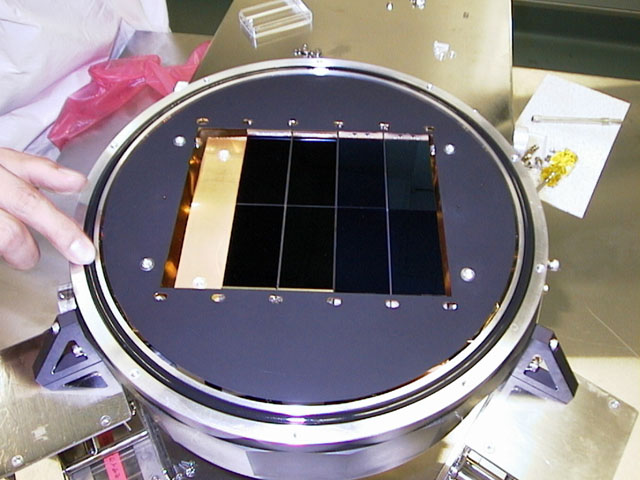
The SDF team has taken images of this field in seven passbands: five are wide filters, B, V, Rc, i', z', and two are narrow-band filters used to look for certain emission-line objects, NB_816 and NB_921. In order to fill in all the gaps between the CCDs, the operators take a series of short exposures -- each about 300 seconds long -- with small offsets in position between each. Each passband accumulates 1-3 hours of exposure time per epoch. The result is a large area of very deep images, reaching point sources down to magnitude 26-28.
There's a very nice tool called the SDF Skywalker which allows you to browse Subaru images of the SDF on your computer.
Most of the scientists working with the SDF are interested in cosmology. They use the colors of objects to identify galaxies at low, medium and high redshifts. You can find a list of papers based on measurements in the SDF at the SDF publications page. If you want to do a little science yourself, you can access images and catalogs of objects at the SDF data products page.
There are many epochs of measurements of the objects in the SDF. Some scientists have simply co-added all the epochs to detect the very faintest objects. Others have looked for objects which vary in brightness, concentrating on supernovae.
We realized that with a six-year baseline, it ought to be possible to detect stars which move relative to their neighbors. The largest proper motions known are less than 1 arcsecond per year; a typical (large) value might be 0.05 arcseconds per year. In six years, such a star would move by 0.3 arcseconds. The SDF images have a FWHM ranging from 0.75 to 1.30 arcseconds, and one can often measure the center of a stellar image to 1/10 or 1/20 of a pixel; let's say 0.06 arcseconds as a round number. That means that some stars might move by five times the uncertainty in their position ... which sounds large enough to give the idea a try.
Many other people have measured proper motions, of course; would this effort break any new ground? Yes, to some extent. The SDF images reach much fainter than most surveys, so we would be probing stellar populations which aren't known very well. There are a few studies of proper motions of very faint stars with HST; those do go as faint as the SDF, or slightly fainter, but cover a much smaller field of view.
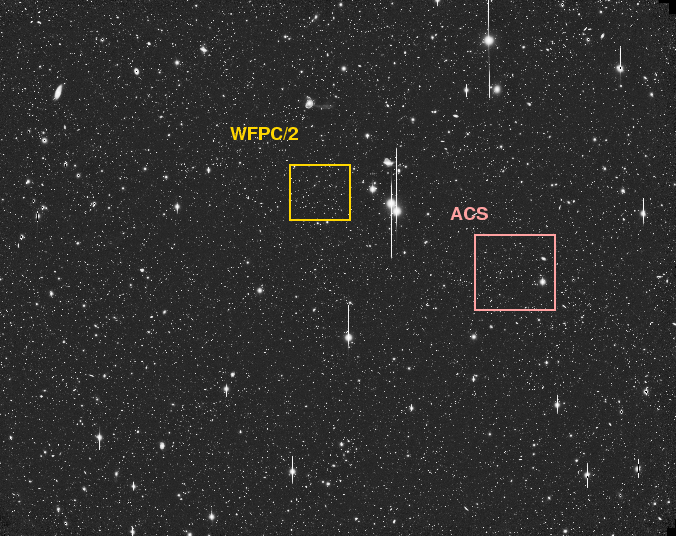
The combination of wide area and faint magnitude limits means that the SDF samples the stars in a very large volume of space. The table below compares it to several other surveys for proper motions. I've chosen the magnitude of faint, old white dwarf, Mv = +16.5, to define the distance out to which each survey reaches.

Moreover, the SDF project has accumulated up to 18 epochs of measurements for each star, compared to just 2 or 3 for many proper motion studies. That means that we should be able to reduce the number of false positives to levels far below those of some surveys. This is especially important when one is studying faint objects near the limits of detection.
So it's possible to find moving stars in the SDF -- but what could we learn from them? Well, since the SDF is located near the North Galactic Pole, the stars in it are likely to belong to the thick disk and halo populations, rather than the ordinary thin disk population of which the Sun is a member. If we combine our proper motion measurements with (future) radial velocity measurements, we can determine the full three-dimensional space velocities of stars. Such detailed information might tell us something about the dynamics of the different stellar populations in the Milky Way ... especially the halo.
In addition, there is an open question about one component of the halo population: white dwarfs. How many are there in the halo of our Galaxy? Is it possible that they might contribute a significant fraction of the halo's mass? Finding white dwarfs in the halo is difficult, because
However, it is possible that some of the white dwarfs in the halo might be zooming through the disk of the Milky Way in their orbits right now, and so pass not too far from the Sun. Since they (and other halo stars) don't participate in the same 200 km/s rotation around the center of the Galaxy as the Sun (and other disk stars), they will have very large relative velocities, and thus relatively large proper motions. A careful search of faint stars in a large volume of space might uncover some of these elusive stars. Our current catalogs of halo white dwarfs are so small that adding even five or ten new members would be significant.
The basic idea is pretty simple:
Let's walk through this idea, one step at a time.
We started with a single seamless mosaic image from each epoch, created from several, dithered, individual exposures. We chose to use i'-band images because some of our likely targets would be relatively cool and red. We used a simple method(*) to detect point sources in each image and measure its brightness through circular apertures.
(*) the stars and pht programs from the XVista package
Since we didn't care about galaxies, just stars, and since we also were more interested in POSITIONS than magnitudes or other properties, this simple procedure was good enough.
The result was a list of between roughly 20,000 and 120,000 objects for each epoch -- more when the seeing was good and the total exposure time was longer.
Did we find every star in that region of the sky? No, of course not: we only noticed the bright ones. In order to quantify this important fact, I added artificial stars to the images and ran our routines to detect and measure the stars. We found nearly every bright artificial star, but only a small fraction of the faint ones. This tells us our efficiency as a function of magnitude, and gives us a simple way to describe the completeness of our search.

We broke up these very large lists into smaller pieces by dividing the area of the SDF into a regular grid of 9-by-11 square sections. Each section was about 1000 pixels on a side, with a small extra amount for overlap between neighboring sections. In part, we did this simply to make the subsequent processing easier; but it also helps to reduce the effects of any large-scale spatial distortion across the focal plane: we will be comparing the position of each star to its neighbors, rather than to objects half a degree away.
We then used the match package to compare the objects in this section to objects in the same section in the fiducial epoch: UT 2007 Feb 15. We allowed for a general linear transformation (translation, rotation and scaling) between the two lists of objects. The maximum permitted matching distance between an object in the two epochs was 5 pixels, which corresponds to about 1 arcsecond. Given a maximum six-year difference in time, this places an upper limit of about 0.17 arcsecond per year in the proper motion we can detect.
Most of the stars, of course, didn't move perceptibly during our period of observations. We can use them to estimate the uncertainty in our measurements of position. As the upper two rows of the table shows, this uncertainty is small for bright stars and large for faint ones -- no surprise.

To find the stars which DID move, we took two steps. First, we made a quick calculation of the average position of a star during the first two years of the survey (2001-2002) and the average position during the final year (2007). If those two average positions differed by less than 0.08 arcseconds -- in other words, if the two positions were pretty much unchanged from start to end of the survey -- we discarded the star. That left us with about 10,000 candidates.
The second step was more sophisticated. We looked at the position of each star in the row and column coordinates separately. For each direction, we fit a straight line to the positions as a function of time. Our fitting routine provided both the slope of that line, and a value for the uncertainty in the slope. In order for a star to pass this test, the ratio
slope of line
significance = --------------------
uncertainty in slope
had to be large in either one of the directions, or in a combination of the two directions. Below is an example of one of the candidates which passed this test.


We accepted any star which had a combined significance level which corresponds roughly to "10-sigma". That led to 110 candidates.
After examining each candidate by eye, we discovered that five of them were spurious, due to the combination of light from several sources. That left 105 candidates with large proper motions .
Below are three examples of our candidates.
As a check to our procedure, we can look at the distribution of "motions" for objects which have a high significance -- such as the set of 105 solid candidates -- and those of low significance. Stars which don't really move, but simply have random errors in their measurements, are equally likely to have spurious (small) apparent motions in all directions. And, indeed, they do:

On the other hand, stars which are really moving ought to show some signature of kinematics in the Milky Way. The Sun, for example, is revolving around the center of our Galaxy in a circular orbit at about 200 km/s; halo stars, on the other hand, do not share this circular motion. Therefore, we expect to see halo stars zoom past us in one particular direction; that direction depends on which way we look. We called upon the excellent Besancon stellar population synthesis model to tell us which direction we should EXPECT stars to be moving.

We generated several random instances of stellar populations in the direction of the SDF, then picked those objects which fell into the magnitude and color limits of our survey. The resulting collection of simulated stars showed a pronounced asymmetry in their proper motions as seen from the Sun ... and we see that same asymmetry in the actual observed proper motions. This confirms that we are detecting real moving stars.

What can we say about these stars with high proper motions? Well, the the SDF catalog provides magnitudes for each object in five wide passbands. We can, in theory, use these measurements to calculate the colors of each candidate, which in turn might tell us something about its physical properties.
Unfortunately, some of the candidates are very red. They show up clearly in the i'-band images we used to search for proper motion, but they do NOT appear in images taken at shorter wavelengths, such as B-band. Of the 105 candidates, 6 were so red and faint that we could not extract reliable B or V magnitudes. We discarded those objects, leaving 99 candidates with reliable motions and colors.
One of the astronomer's most useful tools is the color-magnitude diagram. If we know both the color and the absolute magnitude (or luminosity) of a star, we can tell if it is still on the main sequence and burning hydrogen, or if it has moved into a later evolutionary stage.
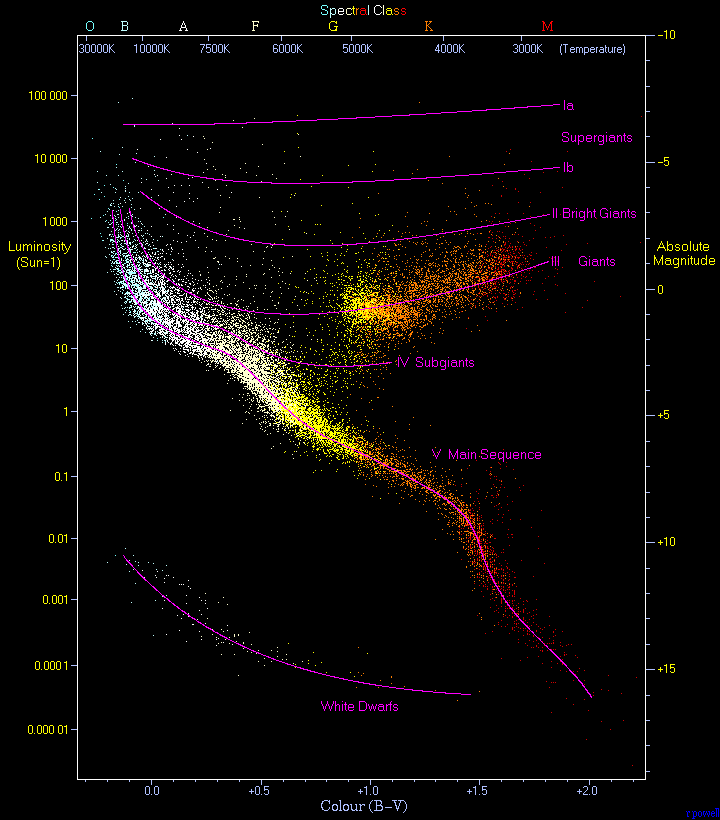
Image courtesy of anzwers.org
Unfortunately, in order to determine the absolute magnitude of a star, we need to know its distance. We do not know the distances to our candidates in the SDF, and so we can't place them onto a color-magnitude diagram.
However, there is something we can do. We can use their motions as proxies for their distances. To some extent,
Astronomers who use proper motions long ago (in 1922!) came up with a mathematical expression which replaces the distance d to a star with an expression based on its apparent proper motion μ.

The quantity H is called reduced proper motion. We can use it in place of absolute magnitude to make a graph analogous to the color-magnitude diagram. In this reduced-proper-motion diagram, the position of a star isn't identical to its position in the color-magnitude diagram ... but we can still distinguish between different types of stars. I'll first show a version of this diagram with synthetic model stars only, to give you an idea of what we might expect to see.

As you can see, stars belonging to different populations will tend to fall in different regions of the reduced-proper-motion diagram. In particular, the left side of the lower portion is the domain of white dwarfs: stars which are relatively hot (and therefore blue), yet very low in luminosity.
Now, let's plot our 99 candidates on this sort of diagram. In order to reduce confusion, I'll use tiny dots for all the stars in the synthetic model, and big squares with errorbars for the 99 real candidates.

Many of our candidates fall into the "halo" region of the diagram, suggesting that they are main-sequence stars in the halo of the Milky Way. There are a few candidates in the "white dwarf" region. But what about the bunch which lie in the angle between the "white dwarf" and "halo" regions?
Well, that's a good question. There are several possibilities:
What are sub-dwarfs? They are stars which are burning hydrogen to helium in their interiors, like ordinary dwarfs, but which have a different chemical composition: their outer atmospheres have a lower content of "heavy elements" such as carbon, iron, silicon, etc. They are called "sub-dwarfs" because in an ordinary color-magnitude diagram, they appear underneath the ordinary dwarfs. Or, put another way, they are bluer than regular dwarfs of the same luminosity.

A long sequence of epochs permits one to look for stellar motions; it also allows one to look for variability in brightness. Are any of our proper-motion candidates variable stars?
Before we go any further, it is necessary to point out that our sampling is very sparse: twenty epochs over six years means an average of three measurements per year, and those are clumped together within a single season. There are many types of variable stars which have relatively small amplitudes and short periods, on timescales of days or weeks; we simply wouldn't detect their variations very well. Our passband, i'-band, is in the far red portion of the optical, centered at about 7700 Angstroms. Most types of variable stars show less variation in the red than the blue.
However, we can still look for changes in brightness among our 99 candidates. We decided to perform ensemble photometry on a group of stars centered on each candidate; that way, any small variations in sensitivity across the focal plane would not induce any spurious variations. We looked at roughly 100-400 stars around each proper motion candidate and calculated (skipping some important but messy details here ...)
If we make a graph which shows the standard deviation as a function of magnitude for all the stars in an ensemble, we typically see a pattern which looks like this:

Bright stars show only a small scatter from their mean values, while faint stars show a large scatter. In a field with no variable stars, there will be a smooth locus curving up and to the right. In this particular instance, there is one outlier, at about i' = 21.2, which has a much higher scatter than other stars of similar brightness. That might be a real variable star.
The candidate in this ensemble, however, marked by the red symbol, lies right in the middle of the main locus. There is no evidence that it varies in brightness more than its neighbors.
Performing a similar analysis for all 99 candidates, we find that none of them has any strong evidence for variation in brightness. Rats.
There are three things we can (and will) do to continue our study of moving stars in the SDF:
We'll be applying for time on Subaru to make these observations soon: the deadline for Spring 2009 observing is in September, 2008.
There are 72 objects with slightly lower levels of significance to their motion: 4.0 < Stot < 5.0. Many of these objects, perhaps the majority, will also turn out to be real moving stars. We simply need to look at each one closely.
It is also possible, though unlikely, that there might be some very distant objects belonging to our own solar system in these images. The ecliptic latitude is 33 degrees, which is high, but perhaps not too high. We would have to make a special kind of search with new procedures to find solar system objects, since they would move very rapidly. However, if we examined only the images taken during one season at a time, without requiring nearby matches in images from other years, we might find something ...
But that is not all we can do. The SDF is not the only area on the sky which the Subaru Telescope has examined repeatedly. For example, the Subaru/XMM-Newton Deep Survey (SXDS) involves many images of a region which is located almost opposite to the SDF in the sky. If we repeat our current analysis procedure for the images of the SXDS, we will have data on the space motions of stars both above and below the galactic plane.